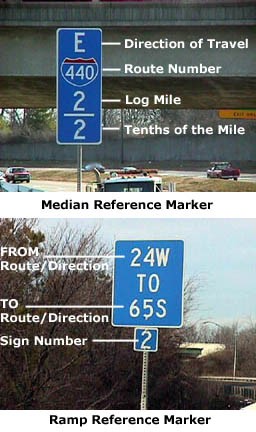Reference Markers
What is the purpose of the blue signs placed along the medians and ramps of the Interstate highways in Chattanooga, Knoxville, Memphis and Nashville?
The blue signs are known as reference markers. In emergencies, the signs serve the same purpose as street addresses on other streets and highways. TDOT is testing the use of these signs to improve emergency response to Interstate crashes and other incidents.
When a problem occurs on an Interstate highway, passing motorists call "911" or "*THP," and those calls are important to quick response. However, callers are frequently unclear about their exact location, route, and direction of travel. Without that information, the emergency responders—law enforcement officers, fire and emergency medical services, the HELP operators, and others—have trouble knowing the location, exit/entrance ramp to use or even which of the available units should be dispatched.

Median Reference Markers
TDOT has installed two signs, one facing in each direction, along 228 miles of Interstate highways in the four metropolitan areas. Each sign gives four pieces of information:
- Direction of travel
- Interstate route
- Milepost
- Tenth of a mile past the indicated mile post.
If you report an emergency, look ahead in your direction of travel for a blue sign, and then report all of the information. For instance, "The crash is eastbound on Interstate 440, near mile 2.2 (2 and 2/10ths)."
NOTE: Signs are placed in both directions of travel, often back-to-back on the same post. If you look behind you at a sign in the opposite direction of travel, the sign will indicate that direction and, therefore, the opposite side of the interstate.
Ramp Reference Markers
You may have also noticed signs on ramps from one interstate to another interstate. The ramp reference marker shown on this page tells you (and emergency responders) that you are on the ramp from Interstate 24 westbound going to Interstate 65 southbound. The small square at the bottom indicates this is the second sign on the ramp. All interstate-to-interstate ramps have three or four of these emergency reference signs equally spaced along the full length of the ramp.